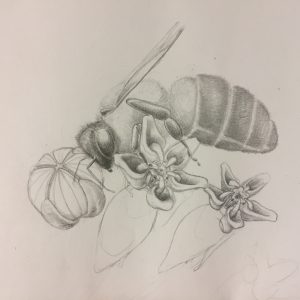1 September – 30 September
September was another busy month for seed collection. However, I was able to find some time to do more than scour the desert for a small, purple aster (Machaeranthera canescens) and stuff its seeds into a manila envelope before the wind snatched them up. When I was not collecting seeds, I could still be found out in the field.

Just another day in the desert. It was cool and rainy on this day, which made for one special treat.

I think these cacti are adorable – except for when they stick to my boots and poke me in the bum as I squat down to collect seeds! Yowch! Unfortunately, that’s happened on more than one occasion…
Earlier in the month, I spent some time in the Caribou-Targhee’s Curlew National Grassland for a monarch butterfly (Danaus plexippus) monitoring project. The Curlew is a harsh, hot environment that has been trying to recover from the Dust Bowl. Yet a stream still manages to make its way through the desert. Along a portion of this stream is a population of showy milkweed (Asclepias speciosa). This area is a prime monarch caterpillar habitat, as there are thousands of milkweed plants around and milkweed is the only plant monarch caterpillars can eat. I have been out to this area multiple times with others from the office and the community to conduct monarch monitoring. The monarch butterfly holds a special place in my heart because I spent two years of my undergraduate degree researching the migratory population of monarch butterflies east of the Rocky Mountains. I have enjoyed working on a project that I have a decent level of background knowledge on, especially after spending so much time trying to familiarize myself with the new projects of my internship. I also enjoy any opportunity to run around with a butterfly net. And, after hearing numerous adults laugh and shout with joy over each butterfly they caught or caterpillar they discovered, it is clear many others also enjoy chasing butterflies through a field.

Monarch (D. plexippus) caterpillar munching away on some showy milkweed (A. speciosa).
If I wasn’t chasing butterflies or collecting seeds, I could be found working on environmental education projects. Throughout the month of September, I spent a couple of days a week at the Upper Mesa Falls visitor center northeast of Ashton, ID. Fourth grade school groups came out here to learn about the geology, hydrology, and history of the area, in addition to the program Every Kid in a Park. I led the students on plant walks and it was great to be around their enthusiasm and eager questions. I also think the Every Kid in a Park program is an awesome opportunity – every fourth grader in the nation gets a pass that allows them free entry to our national parks and monuments! The other education project I worked on has been a pollinator display for local libraries. The Idaho Falls USFS office has partnered with Pocatello’s Idaho Fish and Game office for this project. We recently completed setting up a display about native bees at the Marshall Public Library and it has been rewarding to see the whole project come together.

Upper Mesa Falls produces a rainbow every sunny morning and every clear night on a full moon! The Falls make for one incredible classroom.

If you find yourself at the Marshall Public Library in Pocatello, ID, please stop by and learn a bit about bees native to North America!
As Summer moves out and Autumn moves in, the field season has begun to wind down. It will be interesting to see what else I will be working on as my internship continues into November, but I am hoping I will get to spend quite a few more days out in the field.
Cheers to more adventures!
Shannon
USFS Idaho Falls, ID























